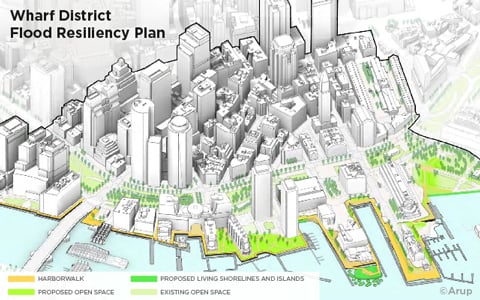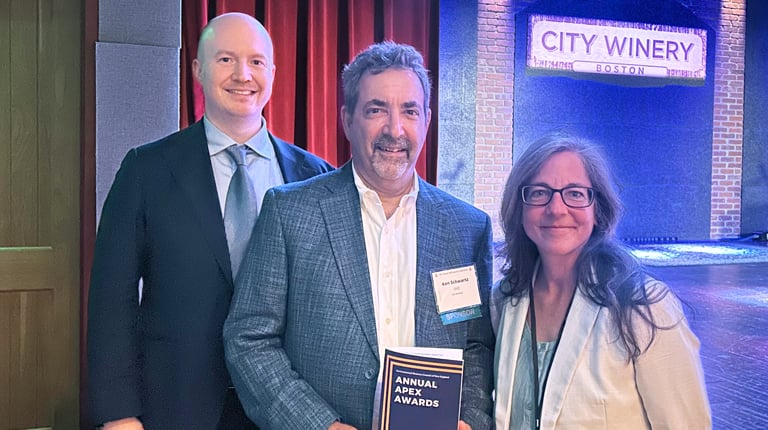
With sea levels projected to rise up to 51.5 inches by 2070, coastal communities and their infrastructure are at risk. The Wharf District Council is getting ahead of the situation in the Boston Harbor, working toward developing and implementing a practicable, district-scale coastal resiliency plan that has buy-in from all impacted property owners, community members, and regulatory agencies. In July 2023, the Wharf District Council released its Conceptual District Protection & Resiliency Plan, a major milestone on its path to coastal resiliency.
Although the need for flood protection in Boston has been clearly identified, there is little precedent for detailed proposals for coastal resiliency projects of this scale in the city. The Conceptual District Protection & Resiliency Plan represents a uniquely pragmatic approach to resiliency design. Striving to gain critical stakeholder support, the Wharf District Council sought to identify only those measures that have a strong chance of being implemented.
That’s where VHB comes in. The project team engaged VHB specifically to examine federal, state, and local regulations that would impact the design of, and ultimately the ability to permit, resiliency measures. “VHB’s in-depth knowledge of waterfront regulations allowed us to be at the forefront of guiding this kind of resiliency project,” said Stephanie Kruel, Senior Regulatory and Resilience Advisor at VHB.
Thanks to the Wharf District Council’s proactive strategy, this was the first coastal resiliency project in Boston to be endorsed by all property owners who will be directly impacted by the proposed district-scale flood protection measures.
For this project, VHB is a teaming partner to Arup, an international engineering and design firm, marking a unique occasion of two civil engineering firms partnering to succeed on an important project, each firm contributing its specialties to the effort.
“The ability of the Arup team to craft successful engineering, permitting, and stakeholder engagement strategies was truly impressive. In particular, the team’s outreach strategy enabled effective connections and conversations with each stakeholder, resulting in unanimous support for a consensus solution among each of the public and private property owners in the project area—something many folks thought impossible when we set out on this journey. I cannot imagine a better partner,” said Marc Margulies, Wharf District Council President.
Now that the Wharf District Council has released its resiliency plan, VHB’s next step will be to share the project with various regulatory agencies for their feedback on VHB’s proposed permitting strategies. Stephanie says that while there is a general perception that securing permits for resiliency measures can’t be done, she believes that permitting this type of infrastructure is more achievable than people think; it just requires carefully examining existing regulations and questioning assumptions to identify what truly impedes resilience measures. VHB’s ability to dive deep into regulations is one of its keys to success in propelling the resilient solutions that benefit our communities.
Connect with Stephanie Kruel via email or LinkedIn to learn more about VHB’s resiliency services.


